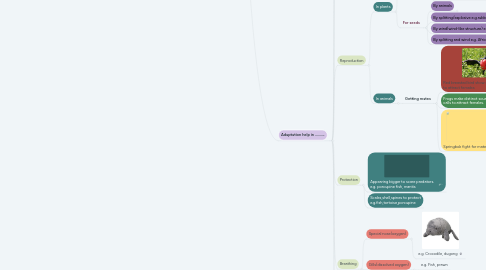
1. What does adaptation help?
1.1. -Movement -breathing -getting food -making food -protection -dealing with harsh weathers -reproduction
2. What is adaptation?
2.1. It is special characteristics or features that help the animal to survive or reproduce.
3. Adaptation help in ..........
3.1. Movement
3.1.1. In air:
3.1.1.1. Bats have wings that are skin stretched on their bones and powerful muscles to help flight.
3.1.1.2. Birds have wings that are made out of feathers and powerful muscles and bones are strong and hollow to have less weight.
3.1.1.3. Flies are light and wings are thin to reduce weight.
3.1.2. In water:
3.1.2.1. Aquatic animals or animals that usually hunt in water have streamlined body shape to reduce water resistance and can move faster. (Water resistance is like friction on land but it is in water)
3.1.3. On land:
3.1.3.1. Running: Strong muscles on legs to overcome gravitational force and strong soles for the feet to overcome frictional force.
3.1.3.1.1. e.g. Horse
3.1.3.2. Hopping: Strong muscles on leg and flat soles for feet.(And tail for balancing when land.)For some.
3.1.3.2.1. e.g. Kangaroo rat
3.1.3.3. Slither: Scales on the part that is sliding on to overcome frictional force and strong muscles beside body to slither.
3.1.3.3.1. e.g. Snakes
3.2. Getting food
3.2.1. Types of part and uses to hunt
3.2.1.1. Sharp claws e.g. lion
3.2.1.2. Strong jaws e.g. tiger
3.2.1.3. Webs and traps e.g. spider
3.2.1.4. Sticky tongue e.g. chameleon
3.2.1.5. Poison e.g. snakes
3.3. Dark environments
3.3.1. Eyes able to reflect every single little light available
3.3.1.1. e.g. Cat
3.3.2. Lighting up
3.3.2.1. e.g. Anglerfish
3.3.3. Sharp eyesight and hearing
3.3.3.1. e.g. Owl
3.4. Reproduction
3.4.1. In plants
3.4.1.1. For flowers
3.4.1.1.1. By wind(anthers must be hanging out of the flower and must produce a lot of pollen, stigma must be feathery)
3.4.1.1.2. By insect(bright coloured, sweet scent)
3.4.1.2. For seeds
3.4.1.2.1. By animals
3.4.1.2.2. By splitting/explosive e.g.rubber
3.4.1.2.3. By wind(wind-like structure) e.g. shorea
3.4.1.2.4. By splitting and wind e.g. African tulip
3.4.2. In animals
3.4.2.1. Getting mates
3.4.2.1.1. Red breasted bird show certain part of body to attract females
3.4.2.1.2. Frogs make distinct sounds called mating calls to attract females.
3.4.2.1.3. Springbok fight for mates.
3.5. Protection
3.5.1. Appearing bigger to scare predators. e.g. porcupine fish, mantis
3.5.2. Scales,shell,spines to protect e.g.fish,tortoise,porcupine
3.6. Breathing
3.6.1. Special nose(oxygen)
3.6.1.1. e.g. Crocodile, dugong
3.6.2. Gills(dissolved oxygen)
3.6.2.1. e.g. Fish, prawn
3.6.3. Gill chambers(dissolved oxygen)
3.6.3.1. e.g. Crab
3.6.4. Air tube(oxygen)
3.6.4.1. e.g. Mosquito larva
3.6.5. Air bubble(oxygen)
3.6.5.1. e.g. Water beetle & Water spider
3.6.6. Moist skin(dissolved oxygen)
3.6.6.1. e.g. Frog
3.7. Plants getting enough sunlight
3.7.1. Land plants->grow straight or twines around a support to get sunlight.
3.7.2. Aquatic plans->air bubbles in leaf stalk to float or air bubbles in leaves to keep it upright.
3.8. Dealing with harsh weather
3.8.1. Hot and dry
3.8.1.1. To reduce water loss
3.8.1.1.1. Camels urinates little while kangaroos does not urinate at all! Cactus leaves are reduced to spines and fence fox large ears are to get rid of excess heat.
3.8.1.2. To get enough water
3.8.1.2.1. Mesquite trees roots are long to get water and cactus stem is huge to store water.
3.8.2. Cold weather
3.8.2.1. Polar bears have a layer of fat and they hibernate.
3.8.2.1.1. Hibernation->Life processes becomes slower, needs less energy.
3.8.2.1.2. Bears have thick hair at the leg soles to increase friction on ice.
3.8.2.2. Some birds travel long distances or migrate to warmer regions.
4. 3 Main groups of classifying adaptation
4.1. A: Behavioural adaptation (BA): Unusual behaviours to help survival and/or reproduction.
4.1.1. E.g. Leopard frogs live near ponds/rivers.When they sense danger they will jump in the water. This B.A. helps it to escape from predators. Snakes come out in the morning during a cool weather. This B.A. helps it to maintain body temp.
4.2. B: Structural adaptation (SA): 1.Unusual life processes or 2.parts of body to help survival and/or reproduction.
4.2.1. E.g. 1.Kangaroo rats get enough water from the dry nuts it eats because of the life processes in its body. This S.A. helps it to get enough water. 2.Fish has gills.This S.A. helps it to breathe in water.
4.3. A&B: 1. Behavioural and 2. Structural adaptation
4.3.1. E.g. Male peacocks have: 1. They display them in the mating dance. 2. Bright tail feathers to attract mates.
5. Living things adaptations will never change...(Wrong!!!) Correction:Living things adaptation does change as the environment change.
6. Question time>>
6.1. Is talking an adaptation?
6.1.1. Cool
